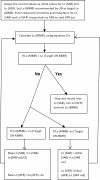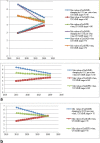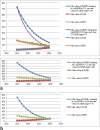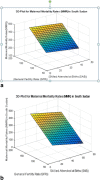Optimal profile limits for maternal mortality rate (MMR) in South Sudan
- PMID: 29970038
- PMCID: PMC6029358
- DOI: 10.1186/s12884-018-1892-0
Optimal profile limits for maternal mortality rate (MMR) in South Sudan
Abstract
Background: Reducing Maternal Mortality Rate (MMR) is considered by the international community as one of the eight Millennium Development Goals. Based on previous studies, Skilled Assistant at Birth (SAB), General Fertility Rate (GFR) and Gross Domestic Product (GDP) have been identified as the most significant predictors of MMR in South Sudan. This paper aims for the first time to develop profile limits for the MMR in terms of significant predictors SAB, GFR, and GDP. The paper provides the optimal values of SAB and GFR for a given MMR level.
Methods: Logarithmic multi- regression model is used to model MMR in terms of SAB, GFR and GDP. Data from 1986 to 2015 collected from Juba Teaching Hospital was used to develop the model for predicting MMR. Optimization procedures are deployed to attain the optimal level of SAB and GFR for a given MMR level. MATLAB was used to conduct the optimization procedures. The optimized values were then used to develop lower and upper profile limits for yearly MMR, SAB and GFR.
Results: The statistical analysis shows that increasing SAB by 1.22% per year would decrease MMR by 1.4% (95% CI (0.4-5%)) decreasing GFR by 1.22% per year would decrease MMR by 1.8% (95% CI (0.5-6.26%)). The results also indicate that to achieve the UN recommended MMR levels of minimum 70 and maximum 140 by 2030, the government should simultaneously reduce GFR from the current value of 175 to 97 and 75, increase SAB from the current value of 19 to 50 and 76.
Conclusions: This study for the first time has deployed optimization procedures to develop lower and upper yearly profile limits for maternal mortality rate targeting the UN recommended lower and upper MMR levels by 2030. The MMR profile limits have been accompanied by the profile limits for optimal yearly values of SAB and GFR levels. Having the optimal level of predictors that significantly influence the maternal mortality rate can effectively aid the government and international organizations to make informed evidence-based decisions on resources allocation and intervention plans to reduce the risk of maternal death.
Keywords: Ln multi-regression; Maternal mortality rate; Optimisation; Profile limits; South Sudan.
Conflict of interest statement
Authors’ information
G. Makuei is a PhD candidate at RMIT University, Melbourne, Australia and was a lecturer for statistics and operation research courses at DR John Garang University of Science and Technology from 2010 to 2012, Bor, South Sudan. Mali Abdollahian and Kaye Marion are both senior lecturers and lecturers at RMIT University, School of Science, Melbourne, Australia.
Ethics approval and consent to participate
To conduct this research the ethical approval was obtained from South Sudan Government through Ministry of Health (MoH), the Ethical Review Committee of the National Medical Body, Juba, South Sudan. Informed consent was obtained from the Head of Department of Health Policy, Planning, Budgeting and Research with Department Reproductive Health, Ministry of Health (MoH) S. Sudan, before the research commenced. It also has been approved and registered by the authority concern from the RMIT University, under registration number: ASEHAPP 97–16, Melbourne, Australia.
Consent for publication
Not applicable.
Competing interests
The authors declare that they have no competing interests.
Publisher’s Note
Springer Nature remains neutral with regard to jurisdictional claims in published maps and institutional affiliations.
Figures




Similar articles
-
Optimal Profile Limits for Maternal Mortality Rates (MMR) Influenced by Haemorrhage and Unsafe Abortion in South Sudan.J Pregnancy. 2020 May 28;2020:2793960. doi: 10.1155/2020/2793960. eCollection 2020. J Pregnancy. 2020. PMID: 32566298 Free PMC article.
-
Risk Factors for Non-use of Skilled Birth Attendants: Analysis of South Sudan Household Survey, 2010.Matern Child Health J. 2016 Jun;20(6):1266-79. doi: 10.1007/s10995-016-1928-x. Matern Child Health J. 2016. PMID: 26961143
-
Maternal mortality ratio in Jiangsu Province, China: recent trends and associated factors.BMC Pregnancy Childbirth. 2021 Jun 25;21(1):447. doi: 10.1186/s12884-021-03897-0. BMC Pregnancy Childbirth. 2021. PMID: 34172025 Free PMC article.
-
Demand-side interventions for maternal care: evidence of more use, not better outcomes.BMC Pregnancy Childbirth. 2015 Nov 13;15:297. doi: 10.1186/s12884-015-0727-5. BMC Pregnancy Childbirth. 2015. PMID: 26566812 Free PMC article. Review.
-
Monitoring and evaluation of skilled birth attendance: a proposed new framework.Midwifery. 2011 Jun;27(3):350-9. doi: 10.1016/j.midw.2011.03.006. Epub 2011 May 23. Midwifery. 2011. PMID: 21601324 Review.
Cited by
-
Analyzing maternal mortality rate in rural China by Grey-Markov model.Medicine (Baltimore). 2019 Feb;98(6):e14384. doi: 10.1097/MD.0000000000014384. Medicine (Baltimore). 2019. PMID: 30732175 Free PMC article.
References
-
- Alkema L, Chou D, Hogan D, Zhang S, Moller AB, Gemmill A, Fat DM, Boerma T, Temmerman M, Mathers C, et al. Global, regional, and national levels and trends in maternal mortality between 1990 and 2015, with scenario-based projections to 2030: a systematic analysis by the UN maternal mortality estimation inter-agency group. Lancet. 2016;387(10017):462–474. doi: 10.1016/S0140-6736(15)00838-7. - DOI - PMC - PubMed
-
- (NBS) MoHMaNBoS . The Republic of South Sudan: The Sudan Household Health Survey 2010. South Sudan: (NBS) MoHMaNBoS. Juba; 2014.
-
- Trends in Maternal Mortality: 1990 to 2015: estimates by WHO, UNICEF, UNFPA, World Bank Group and the United Nations Division.
-
- Rau A. Borgen. 2015. Reducing maternity mortality rate in South Sudan.
MeSH terms
LinkOut - more resources
Full Text Sources
Other Literature Sources
Medical

